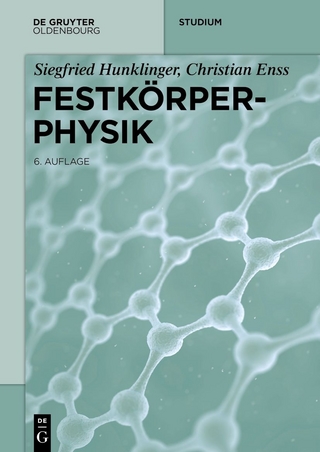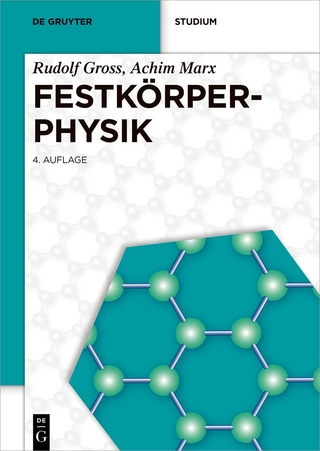
Photoelastic and Electrooptic Properties of Crystals
Kluwer Academic / Plenum Publishers (Verlag)
978-0-306-31101-7 (ISBN)
- Titel ist leider vergriffen;
keine Neuauflage - Artikel merken
1. Photoelasticity of Crystals. Introduction.- 1.1. Discovery of the Phenomenon of Photoelasticity.- 1.2. Mathematical Formulation and Neumann's Constants. Pockels' Contribution.- 1.3. A Brief Historical Survey.- 1.3.1. Amorphous Solids.- 1.3.2. Cubic Crystals.- 1.3.3. Uniaxial and Biaxial Crystals.- 2. Mathematical Tools, Tensor Properties of Crystals, and Geometrical Crystallography.- 2.1. Linear Transformations.- 2.1.1. Coordinate Transformations.- 2.1.2. Orthogonality Relations.- 2.1.3. The Determinant of the Matrix [?ij] of the Direction-Cosine Scheme.- 2.2. Matrix Algebra.- 2.2.1. Introduction.- 2.2.2. Matrix Algebra and Coordinate Transformations.- 2.2.3. Some Common Types of Matrices.- 2.2.4. Orthogonal Matrix.- 2.2.5. Matrix Operators and Transformation of Tensor Components.- 2.2.6. The Diagonalization of a Matrix.- 2.3. Vectors and Their Transformation Laws.- 2.3.1. Vector Components and Coordinate Transformations.- 2.3.2. Transformations of Coordinate Differences.- 2.3.3. Transformation Law of Vectors.- 2.4. Tensor Nature of Physical Properties of Crystals and the Laws of Transformation of Cartesian Tensors.- 2.4.1. Concept of a Tensor Property and Some Examples of Tensor Properties.- 2.4.2. Transformation Law of Cartesian Tensors.- 2.4.3. Physical Properties and Crystal Symmetry.- 2.5. Crystal Symmetry and Geometrical Crystallography. The 32 Point Groups.- 2.5.1. The 32 Crystallographic Point Groups: Their Symmetry Elements and Some Examples of Crystals.- 2.5.2. Some Symmetry Operations and Their Representation by Symbols.- 2.5.3. The 32 Crystallographic Point Groups in the Schonflies Notation. Geometric Derivation.- 2.6. Symmetry Operations and Their Transformation Matrices.- 2.7. Symmetry Elements of the 32 Point Groups.- 2.7.1. Symmetry Elements of the 32 Point Groups.- 2.7.2. Comments on the 32 Crystallographic Point Groups and Their Symmetry Elements as Listed in Tables 2.3 and 2.5a.- 2.8. Neumann's Principle and Effect of Crystal Symmetry on Physical Properties.- 3. Pockels' Phenomenological Theory of Photoelasticity of Crystals.- 3.1. Introduction.- 3.2. Phenomenological Theory, Stress-Optical and Strain-Optical Constants in Four- and Two-Suffix Notations; qij and pij Matrices for the 32 Crystallographic Point Groups.- 3.2.1. The Assumptions Forming the Basis of Pockels' Theory.- 3.2.2. Mathematical Formulation of Photoelasticity in Terms of qijkl and pijkl.- 3.2.3. Mathematical Formulation of Photoelasticity in Terms of qij and pij.- 3.2.4. Crystal Symmetry and the Number of Photoelastic Constants.- 3.3. Derivation of the Nonvanishing and Independent Photoelastic Constants for the Various Crystal Classes by Different Methods.- 3.3.1. Classical Method.- 3.3.2. Tensor Method.- 3.3.3. Group Theoretical Method.- 4. Elasticity of Crystals.- 4.1. Introduction.- 4.2. Stress and Strain as Tensors.- 4.2.1. Stress as a Second-Rank Tensor.- 4.2.2. Strain as a Second-Rank Tensor.- 4.3. Hooke's Law.- 4.3.1. Generalized Form of Hooke's Law with Elastic Constants cij and sij and the Matrices of cij and sij for the 32 Point Groups.- 4.3.2. Generalized Form of Hooke's Law with Elastic Constants cijkl and sijkl.- 4.3.3. Interrelation between cijkl and cmn and between sijkl and smn.- 4.4. Experimental Methods of Determining cij and sij; Christoffel's Equation and Its Use in Determining cij of Crystals.- 4.5. Ultrasonics.- 4.5.1. Introduction.- 4.5.2. Diffraction of Light by Liquids Excited Ultrasonically.- 4.5.3. Optical Methods of Determining the Ultrasonic Velocities and Elastic Constants of Transparent Solids Employing the Schaefer-Bergmann Pattern, the Hiedemann Pattern, and the Lucas-Biquard Effect.- 4.5.4. Mayer and Hiedemann's Experiments.- 4.5.5. Raman-Nath Theory of Diffraction of Light by Ultrasonic Waves.- 4.5.6. Doppler Effect and Coherence Phenomenon.- 4.6. Brillouin Effect and Crystal Elasticity.- 4.6.1. Introduction.- 4.6.2. Theory of Light Scattering in Birefringent Crystals.- 4.6.3. Concluding Remarks.- 5. Experimental Methods of Determining the Photoelastic Constants.- 5.1. Optical Behavior of a Solid under a Mechanical Stress, and Neumann's Constants.- 5.2. Derivation of Expressions for the Stress Birefringence in Terms of qij for Cubic and Noncubic Crystals.- 5.2.1. Stress Birefringence in Cubic Crystals.- 5.2.2. Stress Birefringence in Noncubic Crystals.- 5.2.3. Tensor Method of Deriving q?ijkl in Terms of qmnop.- 5.2.4. Expression for the Change of Thickness in Terms of sij for an Orthorhombic Crystal for a Specific Orientation.- 5.3. Experimental Determination of qij and pij by Optical Methods.- 5.3.1. Measurement of Stress Birefringence, and Relative Path Retardation.- 5.3.2. Measurement of Absolute Path Retardation by Interferometric Methods.- 5.3.3. Photoelastic Studies of Optically Active Crystals.- 5.4. Dispersion of qij by Spectroscopic Methods.- 5.4.1. Birefringent Compensator for Studying Very Small Changes in Double Refraction.- 5.4.2. Dispersion of the Individual Stress-Optical Coefficients q11 and q12 of Vitreous Silica.- 5.4.3. Interference-Spectroscope Method of Studying the Absolute Photoelastic Coefficients of Glasses and Their Variation with Wavelength.- 5.5. Elliptic Vibrations and Elliptically Polarized Light.- 5.5.1. Composition of Two Rectangular Vibrations Giving an Ellipse: Use of the Senarmont Compensator.- 5.5.2. Photometric Method for the Measurement of Photoelastic Birefringence.- 5.5.3. The Poincare Sphere and Its Application to the Study of the Photoelastic Behavior of Optically Active Crystals.- 5.6. Ultrasonic Methods of Studying the Elasto-Optic Behavior of Crystals.- 5.6.1. Introduction.- 5.6.2. Mueller's Theory.- 5.6.3. Experimental Determination of Pij/pkl by Three Different Methods Due to Mueller.- 5.6.4. Pettersen's Method of Determining Pij/pkl.- 5.6.5. Bragg Diffraction Method of Determining the Individual Values of pij.- 5.6.6. Borrelli and Miller's Method of Determining the pij of Glass.- 5.6.7. Technological Applications of the Acousto-Optic Effect.- 5.7. Brillouin Scattering and Photoelasticity of Crystals.- 6. Atomistic Theory of Photoelasticity of Cubic Crystals.- 6.1. Introduction.- 6.2. Mueller's Theory-A Brief Survey.- 6.3. Effect of Hydrostatic Pressure on the Index of Refraction n; The Strain Polarizability Constant ?0.- 6.4. Anisotropy of Rj and ?itj.- 6.5. Thermo-Optic Behavior of Crystals and Photoelastic behavior.- 6.6. Pockels' Photoelastic Groups in Cubic Crystals and Mueller's Theory.- 6.7. Photoelastic Dispersion in Cubic Crystals; ?0 as a Function of Crystalline Material, Wavelength of Light, and Temperature.- 6.8. Effect of Elastic Deformation on the Oscillator Strengths and Dispersion Frequencies of Optical Electrons.- 6.9. Temperature Dependence of Stress-Optical Dispersion.- 6.10. Reversal of the Sign of Stress Birefringence in Pure and Mixed Crystals.- 6.10.1. Pure Crystals.- 6.10.2. Mixed Crystals of KCl and KBr.- 6.11. Stress-Optical and Strain-Optical Isotropy in Cubic Crystals.- 6.12. Optic Axial Angle and Its Dispersion in Stressed Cubic Crystals of T and Th Classes.- 7. Piezoelectricity.- 7.1. Introduction.- 7.2. Direct and Converse Piezoelectric Effects.- 7.3. Mathematical Formulation, Piezoelectric Constants dijk in Tensor Notation, and dij in Two-Suffix Notation; Relation between dijl and dij.- 7.4. Deduction of the Surviving dijk for Some Crystal Classes by Tensor Method, and the dij Matrices for the 21 Noncentrosymmetric Classes.- 7.5. Concluding Remarks.- 8. Electro-Optic Effects in Crystals: Pockels Linear Electro-Optic and Kerr Quadratic Electro-Optic Effects.- 8.1. Introduction.- 8.2. Demonstration of the Electro-Optic Effects, Linear and Quadratic.- 8.3. Historical Survey.- 8.3.1. Earlier Work.- 8.3.2. More Recent Work.- 8.4. Pockels' Phenomenological Theory of the Linear Electro-Optic Effect in Three- and Two-Suffix Notations, Rijk and rij.- 8.5. Derivation of the Relation between the Linear Electro-Optic Constants of a Crystal: Free and Clamped Constants.- 8.5.1. Discussion: Primary and Secondary Electro-Optic Effects, and Clamped and Unclamped Electro-Optic Coefficients.- 8.5.2. Methods of Obtaining the Primary and Secondary Linear Electro-Optic Effects.- 8.6. Kerr Quadratic Electro-Optic Effect: Pockels' Phenomenological Theory.- 8.7. Crystal Symmetry and the Number of Surviving Linear Electro-Optic Coefficients Rijk and rij and Their Deduction by Tensor Method: rij Matrices for the 21 Noncentrosymmetric Classes.- 8.7.1. Crystal Symmetry and the Surviving Linear Electro-Optic Constants.- 8.7.2. Tensor Method of Deducing the Nonvanishing Independent Rijk.- 8.8. Derivation of the Expressions for ? = f(rij) for Some Typical Crystal Classes and Orientations.- 8.8.1. Cubic System: Classes 23(T) and $$/bar 43m$$ (Td).- 8.8.2. Tetragonal System: Class $$/bar 42m$$ (D2d).- 8.8.3. Trigonal System: Class 32 (D3).- 8.9. Experimental Methods of Determining rij.- 8.9.1. General Description and Application to Some Typical Crystal Classes.- 8.9.2. Some Experimental Methods.- 8.9.3. Methods of Applying the Electric Field to the Crystal Prism.- 8.9.4. Experimental Determination of rij in Some Specific Cases of Crystals.- 8.10. Some Points of Interest on the Use of the Pockels Effect in Crystals, and Half-Wave Voltage V?/2.- 8.11. Some Technological Applications of Pockels Cells (Linear Electro-Optic Devices).- 8.11.1. Use of the Electro-Optic Effect in Technology.- 8.11.2. Some Applications of Electro-Optic Devices.- Author Index.
| Erscheint lt. Verlag | 30.6.1981 |
|---|---|
| Zusatzinfo | 36 black & white illustrations, biography |
| Verlagsort | Dordrecht |
| Sprache | englisch |
| Themenwelt | Naturwissenschaften ► Physik / Astronomie ► Festkörperphysik |
| ISBN-10 | 0-306-31101-1 / 0306311011 |
| ISBN-13 | 978-0-306-31101-7 / 9780306311017 |
| Zustand | Neuware |
| Haben Sie eine Frage zum Produkt? |
aus dem Bereich


